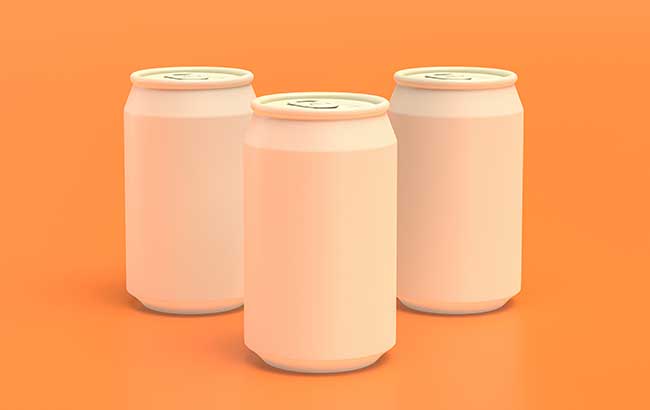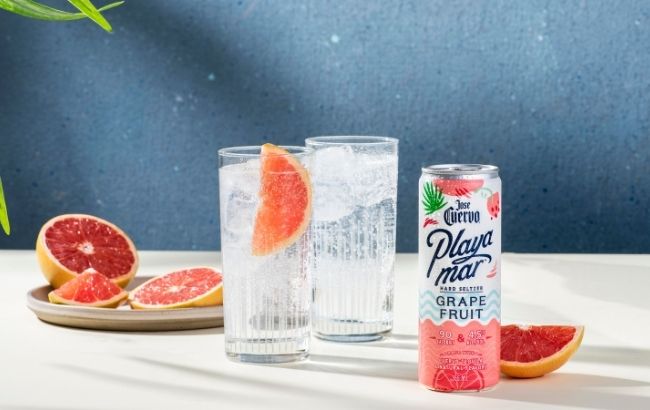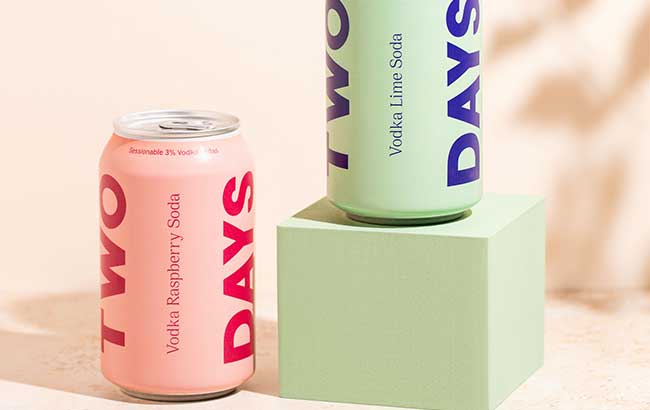Can hard seltzers find global success?
Hard seltzers have been a runaway hit in the US, with big players getting in on this lucrative section of the market. But how is this momentum translating overseas? Melita Kiely investigates.

*This feature was originally published in the April 2021 issue of The Spirits Business
Alcoholic sparkling water – a simple, yet genius concept that has snowballed into a multi‐billion-dollar phenomenon. Over the past couple of years, it’s been nigh on impossible to ignore the meteoric rise of hard seltzers, particularly in the US, where sales have rocketed.
Stateside, the sector has been spearheaded by Mark Anthony Brands’ White Claw, whose ascent to category domination has been remarkable to behold. White Claw sold 400,000 nine‐litre cases in 2014.
By 2019, this number had multiplied to 6.9 million then rose by 298% to 27.5m cases in 2019.
The ability of hard seltzers to tap into numerous trends, such as low‐and‐no, low-calorie and ready‐to‐drink (RTD), has frequently been attributed to aiding the category’s burgeoning success.
However: “The category is driven by flavour – period,” insists Brandy Rand, chief operating officer of the Americas at IWSR Drinks Market Analysis. “While many brands have better‐for‐you attributes, consumers say they choose brands based on flavour first, and have a higher perception of premium RTDs based on flavour. These sensorial aspects – flavour, refreshment, easy to drink – are key to the success of the category.”
In 2019, IWSR forecast hard seltzer sales in the US would more than triple to 281m nine-litre cases by 2023 – a gross underestimation, as Rand explains. “The category will far surpass this by 2021. The rapid growth outpaced expectation, accelerated by Covid, and also buoyed by continued new product innovation, not only from big brands, but domestic craft players.”
Last August, Jose Cuervo launched its Tequila‐based hard seltzer, Playamar, in select US markets. The range comprises two flavours – lime and grapefruit – inspired by Tequila‐based cocktails, and the brand is preparing to expand across the US with the addition of two new flavours: mango, and black cherry.
“For Playamar, our key differentiator is what Cuervo knows best: Tequila,” says Lander Otegui, senior vice‐president of marketing, Proximo Spirits, Jose Cuervo’s distributor.
“While most hard seltzers have a malt alcohol base, Jose Cuervo’s Playamar is created with premium Tequila.
“The growth and trends we see in the US usually have a direct impact on the global market. As the category continues to grow on a global scale, we anticipate the success will be similar.”
After its success in the US, the category has been steadily expanding overseas, as brands strive to generate a similar buzz in international markets. “Hard seltzers really started penetrating markets outside the US in 2020, with a few known US brands and several domestic country brands,” Rand says.

ACQUISITIONS APLENTY
Diageo has been keen to carve a space in the hard seltzer sector, first with its purchase of English producer Chase Distillery, which has line of hard seltzers, then with the launch of Smirnoff Seltzer in the UK last June. Diageo bolstered its portfolio further last month when it bought Far West Spirits, owner of hard seltzer brand Lone River Ranch Water.
“The acquisition is a great addition to our hard seltzer portfolio, it nicely complements our Smirnoff line of seltzers, which continued to grow, as seen with last year’s successful launch of Smirnoff Red, White and Berry Seltzer,” says Jay Sethi, chief marketing officer, Diageo Beer Co USA. “Growth is being driven by consumer trends, such as an interest in lower‐sugar, lower‐calorie and gluten‐free offerings.
“During Covid, these trends have accelerated, and we have seen significant growth in the at‐home occasion as well. We believe these trends are very much here to stay and now provide a sustainable growth opportunity.”
Scotland’s Brewdog Distilling also joined the hard seltzer hype in July 2020 with the launch of Clean & Press. Available in three flavours – cactus and lime, crushed black cherry, and white peach and mango – each variant has an ABV of 5%, contains 90 calories and no added sugar. Brewdog endeavoured to make a point of difference by using a specific base spirit for its hard seltzer line, the distiller’s Rogue Wave Vodka.
“We make all our spirits from scratch under one roof here in Ellon,” says Steven Kersley, head distiller at Brewdog Distilling. “We use malted barley, yeast and water, we turn that into vodka in the course of 14 days, add natural flavour and bring it back down to 5% [ABV] to make our hard seltzer. We tend to see trends that start in the US make their way over to the UK, and we were excited to be one of the first to put it into a can and on the shelves.”
For Kersley and his team, “the challenge we’ve had with hard seltzers is sampling”, he explains, referring to the Covid‐19 pandemic.
“It will be interesting to see if hard seltzers can make the impact everybody thought they could in 2021. The bigger question is will it translate over here to the extent it has in the US, and will we see that adoption of this as something permanent that people return to again and again, like beer or gin and tonics.”
According to Nick Graham, co‐founder of hard seltzer brand Berczy, the UK is “still very much at the education phase”.
In February, UK watchdog the Portman Group released guidance on hard seltzers after research showed 93% of consumers were unfamiliar with the term. Graham’s team has also conducted its own research and reached similar conclusions.
“We did a big sampling survey where we asked 2,500 consumers if they knew what a hard seltzer was,” he says, “95% didn’t know. That terminology is quite confusing for a British consumer – seltzer isn’t a common term over here, and that concept of ‘hard liquor’ isn’t much of a thing in the UK.”
The unfamiliarity of the terms ‘seltzer’ and ‘hard’ to describe alcohol was specifically why Two Days opted to shun the trendy label, despite ticking all the boxes required to call its products ‘hard seltzers’. Co‐founded by Elise Marks and Brendan Bennett, Two Days instead describes its range as a ‘vodka soda’.
“It’s super clear for consumers to understand and allows us the option to expand into other spirits in future,” explains Bennett. “It was important to us to stick to what people know as a vodka soda, but to give it that additional twist.”

Although opinions on the best terminology may differ, where there is consensus is the huge potential for hard seltzers in the UK.
At the moment, Berczy’s Graham says there are more brands than demand, “but it does show everyone’s hedging their bets on this market blowing up”.
“It will open up but it will take time,” he adds. “This summer will be the first part of that movement, but what will become more important are brands’ USPs, ingredients, provenance, social and environmental missions, and flavours; having curious combinations will become important.”
The reopening of the on‐trade will also play a crucial role in the future growth of hard seltzers, Two Days’ Bennett adds.
The pandemic has unfortunately “hindered cans in hands”, meaning it has “probably hindered the growth of the category overall” – a view also taken by Brewdog’s Kersley and Nick Britton, founder of hard seltzer brand High Water.
“On the other hand, it’s probably increased the size of the target market,” Bennett adds.
“I’ve read studies that in the early days of the pandemic people hit the booze pretty hard, but then being stuck indoors made people rethink their relationship with alcohol. They no longer wanted to wake up hungover with nothing to do.
“So while, yes, the pandemic has definitely hindered the initial growth of the category, it has built up this segment of customers looking for better‐for‐you beverages, and now there is a far bigger customer base to target after this year.”
Like Bennett, High Water’s Britton remains incredibly enthusiastic about the potential of hard seltzers – particularly as the world starts reopening after Covid‐19.
As well as ensuring the flavour quality of his hard seltzer brand, which is made with triple-distilled vodka, water from the Cotswolds in England, and layered with all‐natural flavours, the philanthropic values of the brand are also of the highest importance.
“It was important that as part of this venture I could do my bit of good as well,” Britton explains. “All the cans and cartons are plastic‐free and are fully recyclable, and 1% of profits go to Just One Ocean, a UK marine conservation society.”
Far from being a passing fad, Britton is certain the hard seltzer category will become a “mainstay of UK consumer repertoires, for sure. There is enormous growth potential for this category,” he enthuses.
“It you take data points within the US, hard seltzers are getting close to 10% share of beer. Ten percent [in the UK] represents a billion‐pound opportunity; we’re a long way off billion‐pound hard seltzer sales, but the headroom for this is phenomenal, and we’ve barely started on the journey.”
Related news
Cocktail stories: Speed Bump, Byrdi
